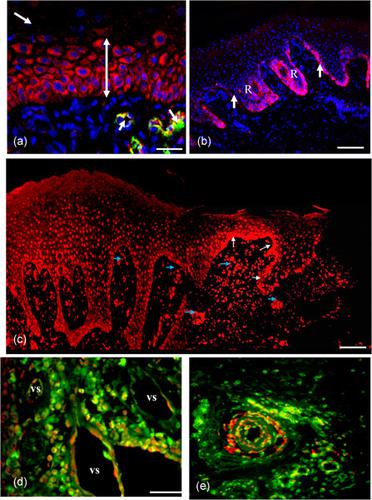当前位置:
X-MOL 学术
›
J. Cell. Physiol.
›
论文详情
Our official English website, www.x-mol.net, welcomes your
feedback! (Note: you will need to create a separate account there.)
A possible role for inducible arginase isoform (AI) in the pathogenesis of chronic venous leg ulcer.
Journal of Cellular Physiology ( IF 4.5 ) Pub Date : 2020-05-27 , DOI: 10.1002/jcp.29812 Seham A Abd El-Aleem 1, 2 , Manal Ismail Abd-Elghany 3 , Entesar Ali Saber 2, 4 , Edward B Jude 1 , Laiche Djouhri 5
Journal of Cellular Physiology ( IF 4.5 ) Pub Date : 2020-05-27 , DOI: 10.1002/jcp.29812 Seham A Abd El-Aleem 1, 2 , Manal Ismail Abd-Elghany 3 , Entesar Ali Saber 2, 4 , Edward B Jude 1 , Laiche Djouhri 5
Affiliation

|
Chronic venous ulcer (CVU) is a major cause of chronic wounds of lower extremities and presents a significant financial and resource burden to health care systems worldwide. Defects in the vasculature, matrix deposition, and re‐epithelialization are the main histopathological changes believed to impede healing. Supplementation of the amino acid arginine that plays a crucial role in the interactions that occur during inflammation and wound healing was proven clinically to improve acute wound healing probably through enhancing activity of inducible arginase (AI) locally in the wounds. However, the possible mechanism of arginine action and the potential beneficial effects of AI/arginine in human chronic wounds remain unclear. In the present study, using biopsies, taken under local anesthesia, from adult patients (n = 12, mean age 55 years old) with CVUs in lower extremities, we investigated the correlation between AI distribution in CVUs and the histopathological changes, mainly proliferative and vascular changes. Our results show a distinct spatial distribution of AI along the ulcer in the epidermis and in the dermis with the highest level of expression being at the ulcer edge and the least expression towards the ulcer base. The AI cellular immunoreactivity, enzymatic activity, and protein levels were significantly increased towards the ulcer edge. Interestingly, a similar pattern of expression was encountered in the proliferative and the vascular changes with strong correlations between AI and the proliferative activity and vascular changes. Furthermore, AI cellular distribution was associated with increased proliferative activity, inflammation, and vascular changes. Our findings of differential expression of AI along the CVU base, edge, and nearby surrounding skin and its associations with increased proliferative activity and vascular changes provide further support to the AI implication in CVU pathogenesis. The presence of high levels of AI in the epidermis of chronic wounds may serve as a molecular marker of impaired healing and may provide future targets for therapeutic intervention.
中文翻译:

诱导型精氨酸酶同工型(AI)在慢性静脉曲张性溃疡发病中的可能作用。
慢性静脉溃疡(CVU)是下肢慢性伤口的主要原因,并且给全世界的卫生保健系统带来了巨大的财务和资源负担。脉管系统,基质沉积和上皮再形成的缺陷是被认为阻碍愈合的主要组织病理学变化。临床上证明,补充在炎症和伤口愈合过程中发生的相互作用中起关键作用的氨基酸精氨酸可以改善局部伤口中的可诱导精氨酸酶(AI)活性,从而改善急性伤口愈合。但是,尚不清楚精氨酸作用的可能机制和AI /精氨酸在人类慢性伤口中的潜在有益作用。在本研究中,使用活检在局部麻醉下从成年患者(n = 12岁,平均年龄55岁)下肢CVUs,我们调查了CVUs中AI的分布与组织病理学变化(主要是增生和血管变化)之间的相关性。我们的研究结果表明,沿着表皮和真皮中溃疡的AI具有独特的空间分布,表达的最高水平在溃疡边缘,而向溃疡基部的表达最少。AI细胞的免疫反应性,酶活性和蛋白质水平在溃疡边缘处显着增加。有趣的是,在增生和血管变化中也遇到了类似的表达模式,其中AI与增生活性和血管变化之间存在很强的相关性。此外,AI细胞分布与增殖活性,炎症,和血管变化。我们发现的AI沿CVU基底,边缘和附近周围皮肤的差异表达及其与增生活性和血管变化的相关性为AI在CVU发病机理中的意义提供了进一步的支持。慢性伤口的表皮中高水平的AI的存在可能是愈合受损的分子标志,并可能为治疗性干预提供未来目标。
更新日期:2020-05-27
中文翻译:

诱导型精氨酸酶同工型(AI)在慢性静脉曲张性溃疡发病中的可能作用。
慢性静脉溃疡(CVU)是下肢慢性伤口的主要原因,并且给全世界的卫生保健系统带来了巨大的财务和资源负担。脉管系统,基质沉积和上皮再形成的缺陷是被认为阻碍愈合的主要组织病理学变化。临床上证明,补充在炎症和伤口愈合过程中发生的相互作用中起关键作用的氨基酸精氨酸可以改善局部伤口中的可诱导精氨酸酶(AI)活性,从而改善急性伤口愈合。但是,尚不清楚精氨酸作用的可能机制和AI /精氨酸在人类慢性伤口中的潜在有益作用。在本研究中,使用活检在局部麻醉下从成年患者(n = 12岁,平均年龄55岁)下肢CVUs,我们调查了CVUs中AI的分布与组织病理学变化(主要是增生和血管变化)之间的相关性。我们的研究结果表明,沿着表皮和真皮中溃疡的AI具有独特的空间分布,表达的最高水平在溃疡边缘,而向溃疡基部的表达最少。AI细胞的免疫反应性,酶活性和蛋白质水平在溃疡边缘处显着增加。有趣的是,在增生和血管变化中也遇到了类似的表达模式,其中AI与增生活性和血管变化之间存在很强的相关性。此外,AI细胞分布与增殖活性,炎症,和血管变化。我们发现的AI沿CVU基底,边缘和附近周围皮肤的差异表达及其与增生活性和血管变化的相关性为AI在CVU发病机理中的意义提供了进一步的支持。慢性伤口的表皮中高水平的AI的存在可能是愈合受损的分子标志,并可能为治疗性干预提供未来目标。











































 京公网安备 11010802027423号
京公网安备 11010802027423号